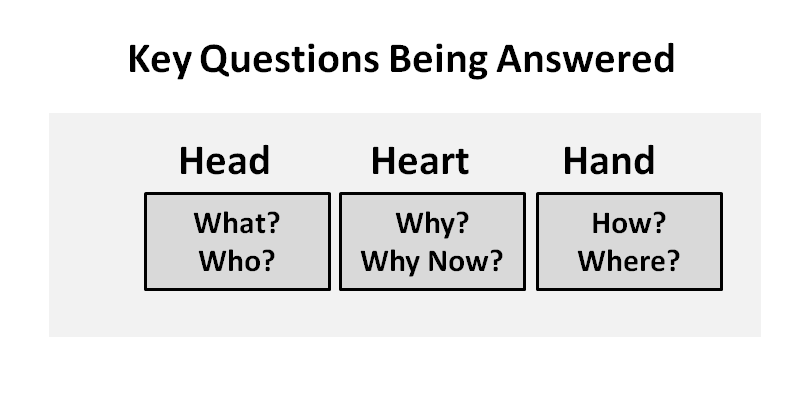After reading Switch (affiliate link) by the Heath brothers, I am convinced that successful consulting projects must appeal to the head, the heart and the hand. It’s a simple way to think about change management, but it also makes a lot of sense. We all want to create sustainable change.
- Head: The logic of the analysis and recommendation
- Heart: Why the client should change
- Hand: Making it easy to implement the change daily
It answers all the key questions that people have. Who, What, Why, When, Where, How. The narrative goes: Yes, we need a strategy and plan (head), leadership and a call-to-action (heart), and some detailed steps (hand).

#1: Head, but no Heart or Hand. This is quite common. The consultants do a great job of solving the problem on paper, but don’t give enough consideration on how the client will motivate (heart) her people to take action, or specifically what the direct reports (hands) need to be doing. Lots of high-power thinking, but that is about it. The solution is too theoretical, complex, or radical. I have heard executives joke that consulting recommendations that were “shelf-ware”because it was so impractical that it went right on the shelf, as if it was a textbook.
#3 Heart, but No Head, No Hand. Executives (CEO, COO, CEO etc) sometimes develop pet projects, especially ones that are related to leaving a legacy, that don’t always pass muster. This is probably one of the main reasons that 2/3 of mergers tend to fail (the destroy economic value).
- Scenario #4: Reckless enthusiasm because there is a lots of vision, passion, and activity, but not much of a plan. Ouch.
- Scenario #5: Strategy without legs because there is a reasonably well thought-out plan and vision, but nothing is happening. The troops don’t know what to do.
- Scenario #6: Disjointed action because there is a strategic plan and roadmap. We all know what needs to be done, but frankly, none of us know why we are doing it – other than our bosses told us to do it.
“For every complex problem there is an answer that is clear, simple, and wrong.” – H.L. Menken
Related Posts:
